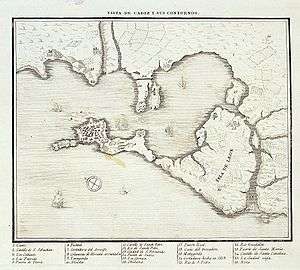Capture of the Rosily Squadron
The Capture of the Rosily Squadron, also known as the Battle of Poza de Santa Isabel, took place on 14 June 1808, in Cadiz, Spain, during the uprising against the French invaders. Five French ships of the line and a frigate were in the port, having remained there under blockade since the Battle of Trafalgar nearly three years earlier. After an engagement with the Spanish lasting five days, French Admiral François Étienne de Rosily-Mesros surrendered his entire squadron with the four thousand seamen then on board.[3]
| Capture of the Rosily Squadron | |||||||
|---|---|---|---|---|---|---|---|
| Part of the Peninsular War | |||||||
 Map of Cádiz | |||||||
| |||||||
| Belligerents | |||||||
|
|
| ||||||
| Commanders and leaders | |||||||
|
|
| ||||||
| Strength | |||||||
|
5 ships of the line, 1 frigate, 4,000 sailors |
5 ships of the line, 1 frigate At least 2,000 sailors and militia, Numerous gunboats | ||||||
| Casualties and losses | |||||||
|
13 dead, 46 wounded, 3,676 captured, 6 ships captured[1][2] Total: 3,735 |
4 dead, 50 wounded, 15 gunboats sunk Total: 54 | ||||||
Background
The spring of 1808 saw a deterioration in relations between erstwhile allies Spain and France, culminating in rebellions against the pro-French kings Charles IV and Ferdinand VII, leading to a French occupation and the placing of Joseph Bonaparte on the Spanish throne.
Under difficult circumstances, Rosily endeavoured to gain enough time for the arrival at Cadiz of French troops which had been dispatched from Madrid to Andalusia. He took up defensive positions, beyond the reach of the land batteries, in the channel which leads to La Carraca. While anchored there, he first offered to quit the bay, in order to quiet the multitude; he next proposed to the British, who were blockading the port, to send his cannon ashore, to keep his crews on board and to conceal his flag. In exchange, he required hostages for the safety of his sick and for the French inhabitants of Cadiz, and a pledge that he should be safe from attack. The British would not consent to this.
The Spanish governor of Cadiz, Tomás de Morla y Pacheco, refused to comply with the Rosily's demands, and instead required that he should surrender his forces. On Rosily's refusal, the Spaniards sited batteries on the Isle of Leon and near Fort Louis.
The French ships and their numbers of guns were:
Neptune 80
Héros 74
Pluton 74
Algesiras 80
Argonaute[4] 74
Cornélie 44
Battle
On 9 June, at 3 PM, a division of Spanish gun and mortar boats and the batteries erected on the Isle of Leon and at Fort Louis commenced hostilities against the French ships with steady fire, which was kept up until nightfall. The Spaniards had even requested that two ships of the line, Principe de Asturias (112) and Terrible (74), help them.
On the following morning, the 10th, the cannonade recommenced and continued until 2 PM, when the French flagship, Héros, hoisted a flag of truce. Shortly afterwards Vice-Admiral Rosily addressed a letter to Spanish governor Morla, offering to disembark his guns and ammunition, but to retain his men and not hoist any colours. These terms were considered unacceptable, the Spaniards prepared to renew the attack upon the French squadron with an increase of force. On the 14th, at 7 AM, an additional battery of 30 long 24-pounders were ready to act and numerous gun and mortar vessels took up their stations. The French ships struck their colours, which in the course of the forenoon, were replaced by those of Spain.
The British were impatient spectators of this action. Admiral Collingwood, who commanded the blockade of Cadiz, made an offer of co-operation, but his offer was refused by the Spanish. It was enough for them that the British should prevent the fleet from escaping; they were not disposed to give them any claim to a prey which would be captured without their aid.[5][6]
The French suffered little human loss, the Spaniards had only four men killed. It being impossible for the French to offer much resistance, and certain of the success of his attack, the Spanish governor, Tomás Morla, did not wish to employ more violent means of destruction, such as heated shot.
Aftermath
Immediately after the surrender of the French fleet, the Spanish Supreme Junta requested the British Admiral give passage in one of his vessels to the commissioners whom it wished to send for the purpose of negotiating with the Government of his Britannic Majesty for an alliance against Napoleon.
Mr George Canning, His Majesty's Foreign Secretary, stated:
"No longer remember that war has existed between Spain and Great Britain. Every nation which resists the exorbitant power of France becomes immediately, and whatever may have been its previous relations with us, the natural ally of Great Britain".[7]
During the journey of 4 July, the British government emitted an order, declaring that all hostilities between Great Britain and Spain would cease with immediate effect.
See also
- Chronology of events of the Peninsular War
Notes
- Alfred Thayer Mahan, p. 195
- 3,676 was the correct number of prisoners according to the Gazette of Madrid
- Thayer Mahan, p. 195
- (Argonaute of 1806)
- Maximilien p. 210
- James p. 14
- Maximilien, p 213
References
- Alfred Thayer Mahan. (1912). The Influence of Sea Power Upon the French Revolution and Empire, 1793-1812. Little, Brown, and Company.
- Foy, Maximilien, comte; Foy, Elisabeth Augustine, comtesse (1827). History of the war in the Peninsula, under Napoleon : to which is prefixed, a view of the political and military state of the four belligerent powers, Vol 1; London : Treuttel and Würtz.
- James, William. Naval History of Great Britain 1793-1820 (1826) Applegath, London.
External links
- La captura de la flota francesa en Cádiz y la evacuación de las tropas españolas en Zelanda en 1808. Revista de Historia Naval (in Spanish)